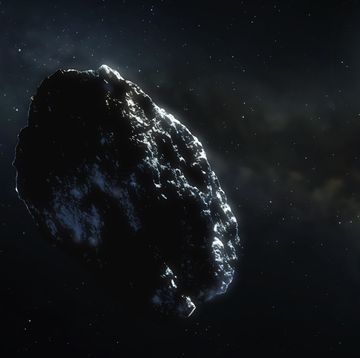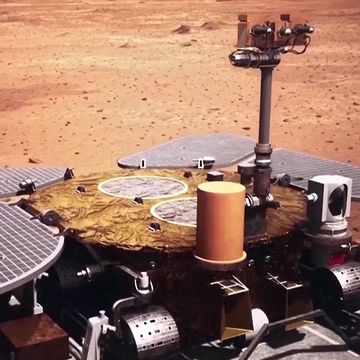Update, 10/20 9:30 a.m. EDT: The ESA ExoMars science team was unable to reestablish contact with the Schiaparelli Mars lander this morning, and it seems likely that the spacecraft is not functional. Preliminary analysis of new data suggests the landing thrusters fired, but cut out sooner than planned, and that the ejection of the back heat shield and parachute occurred earlier than expected.
However, telemetry data from the Schiaparelli lander was collected by the Trace Gas Orbiter, the primary spacecraft of the first ExoMars mission, and relayed to Earth—which should give the science team some new information regarding the velocity and altitude of the lander at given times, helping them figure out what happened.
"Schiaparelli's primary role was to test European landing technologies," said Jan Wörner, ESA's Director General, in a press release. "Recording the data during the descent was part of that, and it is important we can learn what happened, in order to prepare for the future."
Update, 2:45 a.m. EDT: The ESA has said not to "jump to conclusions and let the experts do their work," but unfortunately it sounds like the Schiaparelli lander crash landed on Mars and might not be functional. The original signal being received by the Giant Metrewave Radio Telescope (GMRT) in India was tracking the spacecraft as it entered the atmosphere. A boost in the signal suggests that the parachute was properly jettisoned and the main antenna was exposed, but the signal cuts out before the landing. The GMRT signal was weak, and no one knew if it would be received at all, so scientists eagerly awaited data from ESA's Mars Express Orbiter, which recorded the Schiaparelli lander's decent. The signal was the same, cutting out before the spacecraft reached the surface.
The other ExoMars spacecraft, the TGO orbiter, successfully entered orbit around Mars without any complications. More comprehensive data from both the TGO and from NASA's Mars Reconnaissance Orbiter will help the ExoMars team determined exactly what happened to its lander in the coming days.
Update, 12:36 p.m. EDT: The Trace Gas Orbiter (TGO) spacecraft has successfully reemerged from behind Mars and reestablished a signal with Earth after a two-hour engine burn to slow the craft down and enter Mars orbit. A recording of the Schiaparelli lander's signal has been obtained via ESA's Mars Express Orbiter, and it should be interpreted later today to tell us more about what happened during the landing attempt.
Update, 11:15 a.m. EDT: The signal from the Schiaparelli Mars lander temporarily increased, indicating that the parachute jettisoned and the lander's main antenna was deployed. But the signal cut out as it made its attempted landing—this is not necessarily surprising given the faint signal coming from the spacecraft. ESA's Mars Express Orbiter recorded the landing and will be relaying that information to Earth in about and hour and a half.
Update, 10:50 a.m. EDT: Waiting for a signal from the Schiaparelli lander. You can watch live footage from ESA about the Schiaparelli lander's progress here.
Update, 10:42 a.m. EDT: The Schiaparelli lander is expected to have entered the Martian atmosphere. The six-minute landing procedure will first deploy a parachute to slow the craft from an initial speed of 21,000 km/h. Then the spacecraft will fire retro-rockets to slow even more after the chute is jettisoned. The lander should hover about two meters over the surface of Mars before dropping the rest of the way. The EDM lander uses a deformable bottom that will buckle on impact to protect the spacecraft's main components.
Update, 10:22 a.m. EDT: The TGO spacecraft has begun recording data from the Schiaparelli lander to give a full picture of the landing, though that data will not be relayed to Earth until tomorrow morning. Landing in about 20 minutes.
Original post:
Two ESA spacecraft just reached Mars—the Trace Gas Orbiter (TGO) that will circle the planet to study its atmosphere, and the EDM (Entry, Descent and Landing Demonstrator Module), also known as the Schiaparelli lander, which will be touching down within the hour. Both are part of the ExoMars mission to search Mars for life, which you can read more about here.
The Schiaparelli lander just relayed a signal to the Giant Metrewave Radio Telescope (GMRT) near Pune, India, indicating that it is operational and beginning its final descent. The lander will be touching down on Mars around 10:42 EDT, but it could be a couple hours before a spacecraft orbiting the Red Planet can relay a signal to us to confirm the mission was a success.
The TGO has successfully begun it's main engine burn to slow down and enter Mars orbit, and the engine will fire for a total of about 139 minutes.
This story will be updated as the mission goes on.

Jay Bennett is the associate editor of PopularMechanics.com. He has also written for Smithsonian, Popular Science and Outside Magazine.













